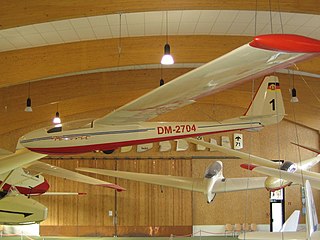Related Research Articles

The ASK 13 is a two-seater glider that was built by Alexander Schleicher. It was and still is widely used for basic training of glider pilots.

The Schleicher K 8 is a single-seat glider designed by Rudolf Kaiser and built by the Alexander Schleicher company of Germany.

The SZD-45 Ogar (Greyhound) is a T-tailed cantilever high-wing monoplane of wooden, aluminium and fibreglass construction designed and manufactured in Poland.

The Slingsby Type 42 Eagle was a two-seat glider designed in England from 1952.

The SZD-25A Lis was a single-seat glider aircraft that was designed and built in Poland from 1955, derived from the SZD-16 Gil and SZD-25 Nov.
The Neiva BN-1 was a high performance single seat sailplane designed in Brazil in the 1950s. It had national record and competition success and went into production for club use.
The CIL Reghin RG-9 Albatros was a tandem seat, all wood glider designed and produced in small numbers at the CIL in Romania in the 1950s.
The I.S.T. L-17 Masang was a two-seat, single engine, low wing monoplane aircraft designed and built in the Philippine Republic in the mid-1950s. It was intended for both touring and training.
The Horikawa H-23B-2 is a two-seat training glider designed and built in Japan in the 1950s. It was produced in small numbers.
The Horikawa H-22B-3 is a simple, open frame, two seat primary trainer glider designed and built in Japan in the 1950s.

The Lommatzsch Lom-61 Favorit is a single seat, high performance glider designed and built in the German Democratic Republic in the early 1960s. A small number were used by clubs.

The Aviamilano A2 or A2 Standard is an Italian high performance Standard Class sailplane first flown in 1964 and returned to production in 1966.
The CVT1 Zigilo was a single-seat, 12-metre-span (39 ft) Italian training glider designed and built in Italy in the 1950s. Only one was completed.
The IIL IS-8 was a two-seat sailplane designed by Iosif Șilimon and built in Romania in 1960. They served with Romanian gliding clubs.
The IIL IS-10 was a high-performance, single-seat glider, designed and built in Romania in the early 1960s. It was the first Romanian aircraft to use laminar flow airfoils.
The IIL IS-11 was an aerobatic, single seat glider, designed and built in Romania in 1959. It was built in small numbers.
The IIL IS-12 was a two-seat glider, designed and built in Romania in 1960. It had a wooden wing but a metal fuselage and was constructed in parallel with the all-wood IS-13 for comparative tests. It was later followed by the IS-13a, a version with an all-metal wing.

The Schleicher Ka-2 Rhönschwalbe is a tandem two-seat training glider designed and built in Germany, in 1952.
The Civil Aviation Department BS-1 Bharani was a tandem seat trainer glider designed and built in India in the early 1960s.
The Civil Aviation Department Kartik was an Indian single seat competition glider first flown in 1963. It was built in small numbers and remained under development until 1975.